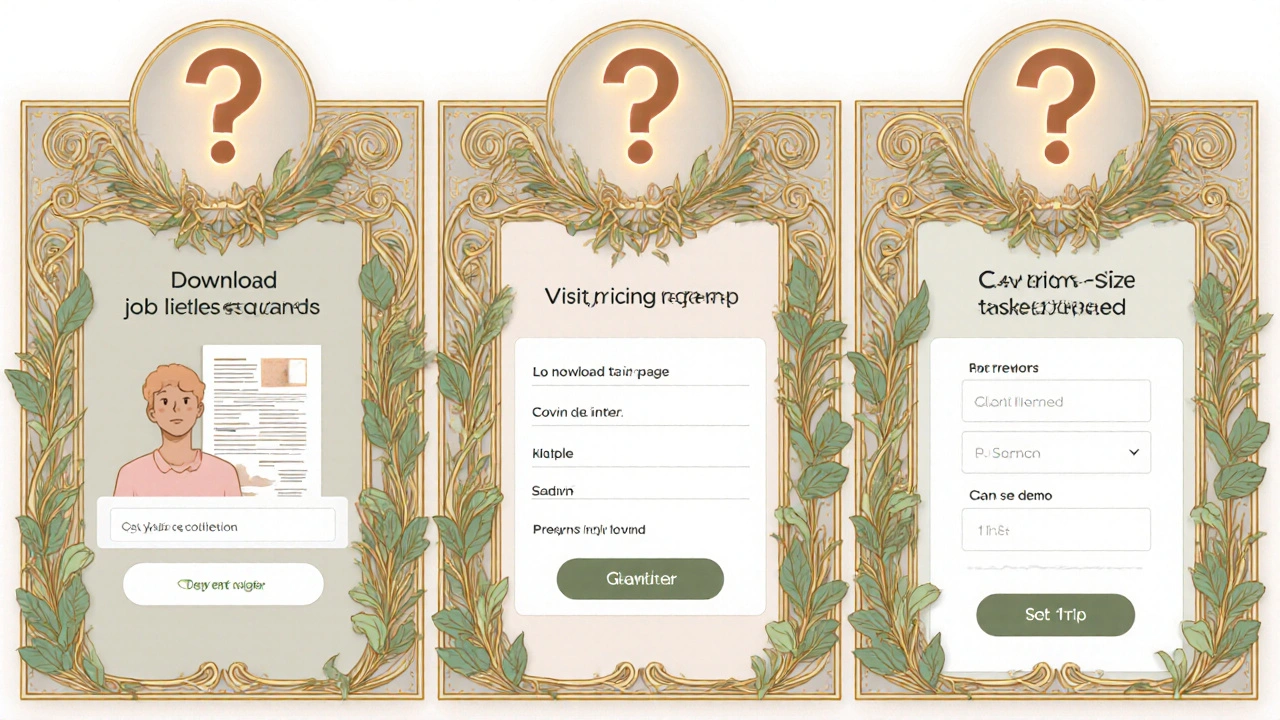Progressive Profiling Strategy Calculator
Build Your Progressive Profiling Strategy
Determine what data to collect and when based on user behavior. Follow the 5-step process recommended in the article.
Your Progressive Profiling Strategy
Imagine signing up for a free trial, and instead of filling out a 15-field form, you only enter your email. A week later, you download a guide - and suddenly, you’re asked for your job title. Two weeks after that, you click on a pricing page, and now they want your company size. No repeats. No overwhelm. Just smart, timely questions that feel helpful, not invasive.
This isn’t magic. It’s progressive profiling.
Most businesses still ask for everything upfront. Name, company, phone, industry, budget, role, location - all on the first page. And guess what? 40 to 60% of people bounce. They don’t trust you yet. They don’t see the value. They’re not ready.
Progressive profiling flips that script. Instead of demanding all the data at once, you collect it in small, meaningful chunks over time. Each piece of information is requested only when it makes sense - and when the user has already shown interest. The result? Higher conversions, richer profiles, and customers who actually feel respected.
How Progressive Profiling Actually Works
It starts simple. Very simple.
On your first visit - whether it’s a landing page, a free tool, or a webinar signup - you only ask for one or two things: email and maybe name. That’s it. No company, no phone, no job title. Just enough to identify them.
Then, you wait for behavior.
When someone clicks on a case study, downloads a pricing sheet, or tries a premium feature, that’s your cue. That’s when you ask for the next piece: “What’s your industry?” or “How many people work at your company?”
Here’s the key: you never ask for the same thing twice. If they already gave you their email in the first form, you don’t ask again. Your system remembers. That’s why it works.
Platforms like HubSpot, Marketo, and Descope sync this data automatically. Every interaction updates the same contact record. Over time, you build a full profile - without ever asking a visitor to fill out a marathon form.
Think of it like getting to know someone. You don’t ask about their childhood, salary, and family drama on the first date. You start with “What do you do?” Then, “Where are you from?” Then, “What’s your favorite travel destination?” Each question builds trust. Progressive profiling does the same thing - but for your leads.
Why This Beats Old-School Forms
Traditional forms are broken. They treat every visitor like they’re ready to buy - even if they’ve never heard of you before.
Baymard Institute found that forms with more than five fields see abandonment rates jump to over 50%. That’s half your potential leads walking away because you asked for too much too soon.
Progressive profiling fixes that. Studies show completion rates for follow-up requests hover above 85%. Why? Because the timing is right. The user is already engaged. They’ve taken a step. Now they’re more willing to give a little more.
And it’s not just about completion rates. It’s about quality.
Salesforce’s 2023 report showed companies using progressive profiling had 27% higher lead-to-customer conversion rates than those using static forms. Why? Because the data they collected was more accurate and more relevant. A lead who gave their job title after reading a whitepaper on HR software is far more qualified than someone who guessed at it on a generic signup form.
Plus, you get behavioral data along with demographic data. You know not just that they’re in marketing, but that they clicked on content about email automation. That’s gold for personalization.
When Progressive Profiling Falls Flat
It’s not magic. If you do it wrong, it backfires.
Some companies think “progressive” means “sneaky.” They ask for a phone number after someone clicks a blog post. Or they request company size before the user has even signed up. That’s not progressive - that’s annoying.
Trustpilot reviews of poorly executed systems average just 1.8 out of 5. The top complaints? “They asked for stuff I already gave them.” “It felt like they were fishing.” “Why do they need my budget now?”
Here’s what kills it:
- Asking for irrelevant data too early
- Repeating questions across forms
- Not explaining why you need the info
- Forcing users to answer non-essential fields
Customer.io’s case study found that letting users skip optional questions boosted completion rates by 41%. People don’t mind giving data - they mind being forced.
Another big mistake? Ignoring device sync. If someone signs up on their phone, then comes back on their laptop, and you ask for their email again - you’ve lost trust. Your system must recognize them across devices. That’s non-negotiable.

What Data to Ask For - and When
There’s no one-size-fits-all sequence. But here’s a proven order that works across industries:
- Initial signup: Email (and optionally, first name)
- After downloading a resource: Job title, industry
- After visiting pricing page: Company size, location
- After watching a demo video: Budget range, decision-making role
- After attending a webinar: Pain points, current tools
Each request should feel like a natural next step. And every time you ask, give something back.
Don’t just say: “Tell us your company size.” Say: “To show you the right pricing plan, we need to know how many people use this tool. It’ll only take 5 seconds.”
Forrester found that companies using clear value exchange - explaining why they need the data - saw 3.2x higher data completeness than those who didn’t.
And don’t forget: zero-party data is the future. That’s info users *want* to share because it improves their experience. Ask for their content preferences. Let them choose what they want to hear about. That’s not profiling - that’s partnership.
How to Set It Up (Without a Tech Team)
You don’t need to be a developer. But you do need a plan.
Here’s a simple six-step process:
- Audit your data needs. What 5 fields actually move the needle? Ignore the rest.
- Map each field to a user action. Which behavior triggers which question? Don’t guess - test.
- Choose your tool. HubSpot, Marketo, or Descope all handle this well. Start with what you already use.
- Build smart forms. Use conditional logic. If they’ve already given you their email, skip it. If they’re from the UK, don’t ask for state.
- Write clear value messages. Every field needs a short reason why you’re asking.
- Test it. Run A/B tests. Compare a 1-field form vs. a 2-field form. See what converts better.
Implementation time varies. Dedicated platforms like Descope can be live in 2 weeks. Older systems like Marketo might take 8-10 weeks. But even a basic version can be up and running in under a month.
And don’t wait for perfection. Start with just one field. Add one more next month. You’ll see results fast.

The Bigger Picture: Privacy, Cookies, and the Future
Progressive profiling isn’t just a nice trick. It’s becoming essential.
With iOS 14, third-party cookies disappearing, and GDPR/CCPA tightening, businesses can’t rely on tracking users across the web anymore. You need first-party data - data users give you willingly.
eMarketer found that 81% of marketers now see progressive profiling as critical to their first-party data strategy. That’s not a trend. That’s survival.
And it’s not slowing down. Oracle just rolled out AI-powered progressive profiling that predicts the *best* time to ask for each piece of data - based on how users behave. Early tests showed 28% higher completion rates.
The IAB is even building standard guidelines so all platforms can talk to each other. Right now, 63% of marketers say their tools don’t sync well. That’s changing.
By 2027, Gartner predicts progressive profiling will be everywhere. Not because it’s trendy - but because it’s the only way to build trust at scale.
Final Thought: Respect Is the New Currency
People aren’t against sharing data. They’re against being treated like a spreadsheet.
Progressive profiling works because it respects the user’s time, their attention, and their autonomy. It says: “I don’t need everything right now. I’ll earn your trust first.”
That’s not just good marketing. It’s good business.
Stop asking for everything. Start asking for the right thing - at the right time.
Your leads will thank you. And your conversion rates will too.

RAHUL KUSHWAHA
This is so true 😊 I used to hate forms that asked for my company size before I even clicked 'try for free'. Now I just close tabs. But when a tool asks for one thing at a time - and actually explains why - I’m way more likely to answer. Felt like they were reading my mind last week. No spam, no pressure. Just respect.